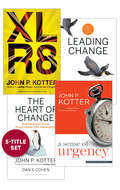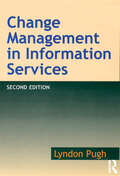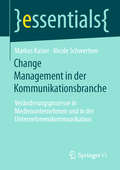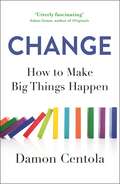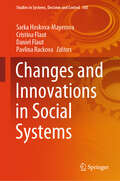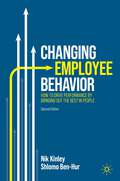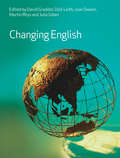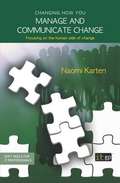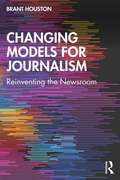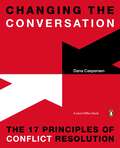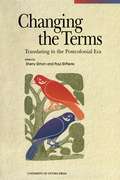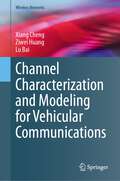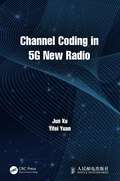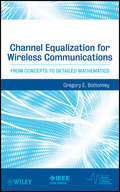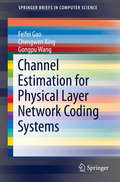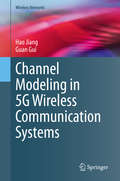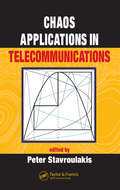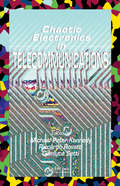- Table View
- List View
Change Leadership: The Kotter Collection
by John P. Kotter Dan S. CohenChange Leadership: The Kotter Collection
Change Management In The Communications Industry: Change Processes In Media Companies And In Corporate Communications (essentials)
by Markus Kaiser Nicole SchwertnerIn media companies and in corporate communications, digital channels are being added to traditional channels. The content is often produced in newsrooms. There is a growing awareness that communication measures are radically oriented towards the needs of the user. In these change processes, special emphasis must be placed on involving the employees. Because only then will the change process be economically successful. This essential shows why media companies and communication departments need a live change culture and how they can approach change systematically.
Change Management in Information Services
by Lyndon PughInformation services are currently going through what is probably the most significant period of change in their history. At the same time, thinking about organisational change in general management has continued to develop, and many of the emerging ideas, strategies and processes are increasingly relevant to information services. Since the first edition of this highly regarded book was published in 2000 the pace of change has accelerated because of the influence of digitisation and technological developments in general, the emergence of what might be called a business culture, changes in skills and knowledge requirements, and changes in user and personnel attitudes. Despite these rapid developments the current literature tends to reflect a preoccupation with technological developments at the expense of consideration for the broader managerial base. This second edition fills the gap in the literature and is fully updated with the inclusion of a number of new chapters and new case studies.
Change Management in der Kommunikationsbranche: Veränderungsprozesse in Medienunternehmen und in der Unternehmenskommunikation (essentials)
by Markus Kaiser Nicole SchwertnerIn Medienunternehmen und in der Unternehmenskommunikation kommen zu traditionellen Ausspielwegen digitale Kanäle hinzu. Die Inhalte werden oft in Newsrooms produziert. Es setzt sich das Bewusstsein durch, dass sich Kommunikationsmaßnahmen radikal am Bedürfnis des Users orientieren. Bei diesen Veränderungsprozessen muss ein besonderer Wert darauf gelegt werden, die Mitarbeiter mitzunehmen. Denn nur dann wird der Change-Prozess auch wirtschaftlich erfolgreich sein. In diesem essential wird aufgezeigt, warum Medienunternehmen und Kommunikationsabteilungen eine gelebte Change-Kultur brauchen und wie sie den Wandel systematisch angehen können.
Change and Exchange in Global Education: Learning with Chinese Stories of Interculturality (Palgrave Studies on Chinese Education in a Global Perspective)
by Fred Dervin Sude Mei Yuan Ning ChenThis unique book starts from the premise that students, scholars, and educators should be given access to a form of global education that is genuinely global. Using the notion of interculturality as change and exchange as a basis, the authors examine fifty discourse instruments (e.g. idioms, neologisms, slogans) related to what they call ‘Chinese stories of interculturality’. China, like other countries, has a rich and complex history of intercultural encounters and her engagement with the notion today, which shares similarities and differences with glocal discourses of interculturality, deserves to be unpacked and familiarized with. By so doing, digging into the intricacies of the Chinese and English languages, the reader is empowered to unthink, rethink and especially reflect on their own take on the important notion of interculturality.
Change: How to Make Big Things Happen
by Damon Centola'A remarkable and important guide to effecting change in our individual lives, businesses, societies - and beyond' JONAH BERGER, bestselling author of ContagiousHow did movements like the Arab Spring and Black Lives Matter take off when they did? How did Lord Kitchener recruit 2,000,000 volunteers at the start of World War I?Why did Twitter take hold while Google+ has failed?What surprising lessons can we learn from Covid 19?From the spread of Covid-19 to the rise of political polarization, from implicit bias to genetically modified food, from NASA to Netflix - it's time to think differently about how change works.Professor Damon Centola is the world expert in the new science of networks. His ground-breaking research across areas as disparate as voting, health, technology and finance has highlighted powerful and highly effective new ways to ensure lasting change. In this book, Centola distils over a decade of deep experience into a fascinating new theory that challenges previous assumptions that new ideas are either contagious or not. Change shows that beliefs and behaviours are not transmitted from person to person in the simple way that a virus is. The real story of social change is more complex and much more interesting. When we are exposed to a new idea, our social networks guide our responses in striking and surprising ways. Drawing on deep-yet-accessible research and fascinating examples, Change presents a paradigm-shifting new science for understanding what drives change, recognising our blind spots and how we can change the world around us.
Changes and Innovations in Social Systems (Studies in Systems, Decision and Control #505)
by Cristina Flaut Daniel Flaut Sarka Hoskova-Mayerova Pavlina RackovaThis book presents challenges and innovations in social problems over the centuries. By their nature, human beings are innovative and continuously adapted to appeared changes over the time. From this point of view, human history can be considered as the story of all changes and innovations which have drastically influenced our way of life. Changes and innovations are normal things in the way of adaptation and are necessary conditions for survival along the time. Changes and innovations are hard and long-term processes. Any progress in history is the result of changes and innovations. To innovate, changes are required: in the culture, in the education, in the way of working, in the way of think, etc. In the same time, innovations imply changes, and changes usually generate reactions. Innovations are always oriented to the future and, in turn, imply changes. From here, the race of evolution was born. Changes require effort, generate resistance but, in the same time, increase performance in almost all domains, and increase vision and leadership; therefore, the progress is obtained. To grew up as a field and provide changes, innovations need to present its theoretical foundations which make sense of the domains on which they are applied. To emphasize the above aspects, the proposed book presents some aspects regarding, but not only limited, to: computer science (new theoretical and practical applications); mathematics (mathematical models, all mathematical results which can improve or are inspired from another known results, some aspects regarding history of mathematics, etc.); education, etc. The chapters of the book present the state of arts of the chosen subjects, from its beginning, its developments, and its applications, by emphasizing the connection with the application or model that the authors have chosen for the presentation.
Changing Employee Behavior: How to Drive Performance by Bringing out the Best in People
by Shlomo Ben-Hur Nik KinleyAn important part of every manager's job is changing people's behavior: improving someone’s performance, helping them better manage relationships with colleagues, or sometimes even stopping them doing something. Yet, despite the fact that changing people's behavior is such a fundamental skill for managers, there is little in the way of systematic support for them to go about it.This book changes that, revealing simple but powerful techniques for changing behavior that experts from a range of disciplines have been using for years. Drawing upon proven methods from psychology, psychotherapy, and behavioural economics, it presents a comprehensive toolkit that managers can use to improve the performance of staff and address some of the most common challenges they face. With a new foreword and three new chapters, this revised edition expands on the original by showing how organisations and leaders have used the techniques presented in it, how these methods have become even more relevant in the post-pandemic world, and how it has been applied the broader challenge of workplace culture change. Finally, supplementary videos add detail to this new content, with examples and explanations presented by the authors.Videos via app: download the SN More Media app for free, scan a link with play button and access videos directly on your smartphone or tablet.
Changing English: History, Diversity And Change
by David GraddolChanging English examines the history of English from its origins in the fifth century to the present day. It focuses on the radical changes that have taken place in the structure of English over a millennium and a half, detailing the influences of migration, colonialism and many other historical, social and cultural phenomena. Expert authors illustrate and analyze dialects, accents and the shifting styles of individual speakers as they respond to changing circumstances. The reader is introduced to many key debates relating to the English language, illustrated by specific examples of data in context.Including key material retained from the earlier bestselling book, English: History, Diversity and Change, this edition has been thoroughly reorganized and updated with entirely new material. Changing English:explains basic concepts, easily located through a comprehensive indexincludes contributions by experts in the field, such as David Crystal, David Graddol, Dick Leith, Lynda Mugglestone and Joan Swanncontains a range of source material and commissioned readings to supplement chapters.Changing English makes an essential contribution to the field of English language studies.
Changing How You Manage and Communicate Change: Focusing on the human side of change
by Naomi KartenDealing with the issue of change from a refreshingly different perspective, this work's premise is that change will proceed more smoothly and effectively if serious consideration is given to the people aspects.
Changing Minds or Changing Channels?: Partisan News in an Age of Choice (Chicago Studies in American Politics)
by Martin Johnson Kevin ArceneauxWe live in an age of media saturation, where with a few clicks of the remote—or mouse—we can tune in to programming where the facts fit our ideological predispositions. But what are the political consequences of this vast landscape of media choice? Partisan news has been roundly castigated for reinforcing prior beliefs and contributing to the highly polarized political environment we have today, but there is little evidence to support this claim, and much of what we know about the impact of news media come from studies that were conducted at a time when viewers chose from among six channels rather than scores.Through a series of innovative experiments, Kevin Arceneaux and Martin Johnson show that such criticism is unfounded. Americans who watch cable news are already polarized, and their exposure to partisan programming of their choice has little influence on their political positions. In fact, the opposite is true: viewers become more polarized when forced to watch programming that opposes their beliefs. A much more troubling consequence of the ever-expanding media environment, the authors show, is that it has allowed people to tune out the news: the four top-rated partisan news programs draw a mere three percent of the total number of people watching television.Overturning much of the conventional wisdom, Changing Minds or Changing Channels? demonstrate that the strong effects of media exposure found in past research are simply not applicable in today’s more saturated media landscape.
Changing Models for Journalism: Reinventing the Newsroom
by Brant HoustonExploring the deep transformation that journalism has undergone in the last decade, this book provides students, professors and working journalists with the background on the demise of traditional media in the U.S. and the changes happening in the digital newsrooms. Houston discusses today’s changes in journalism in the U.S., comparing and contrasting them with those around the world. Topics discussed include the decimation of the traditional newsrooms, contemporary corporate ownership and investors, the rise of bloggers and digital journalism, finding new audiences, the surge in nonprofit newsrooms and collaborations, investigative centers in the U.S. and globally, new model start-ups, and changing streams of revenue with the expansion of new technologies. The text also looks at the new relationship between journalism professionals and the academy, including the rise in content and stories supplied by university-based newsrooms. Houston, who has been on the frontline of these changes, also discusses the culture clashes and ethical dilemmas in cyber environments accompanied by new challenges to maintaining credibility and creating trust. To fully explore the rapid-fire changes in news media and online journalism in recent years, this book will be of interest to students of journalism and communications, working journalists, and professors helping prepare budding journalists for their future careers in journalism.
Changing News Use: Unchanged News Experiences? (Disruptions)
by Irene Costera Meijer Tim Groot KormelinkChanging News Use pulls from empirical research to introduce and describehow changing news user patterns and journalism practices have beenmutually disruptive, exploring what journalists and the news media canlearn from these changes. Based on 15 years of audience research, the authors provide an in-depthdescription of what people do with news and how this has diversifiedover time, from reading, watching, and listening to a broader spectrumof user practices including checking, scrolling, tagging, and avoiding.By emphasizing people’s own experience of journalism, this book alsoinvestigates what two prominent audience measurements – clicking andspending time – mean from a user perspective. The book outlines ways toovercome the dilemma of providing what people apparently want (attentiongrabbingnews features) and delivering what people apparently need (whatjournalists see as important information), suggesting alternative ways toinvestigate and become sensitive to the practices, preferences, and pleasuresof audiences and discussing what these research findings might mean foreveryday journalism practice. The book is a valuable and timely resource for academics and researchersinterested in the fields of journalism studies, sociology, digital media, andcommunication.
Changing the Conversation: The 17 Principles of Conflict Resolution
by Dana CaspersenThe seventeen key principles for transforming conflict—in a beautiful package from the creator of The 48 Laws of PowerFrom Joost Elffers, the packaging genius behind the huge New York Times bestsellers The 48 Laws of Power, The 33 Strategies of War, and The Art of Seduction, comes this invaluable manual that teaches seventeen fundamentals for turning any conflict into an opportunity for growth. Beautifully packaged in a graphic, two-color format, Changing the Conversation is written by conflict expert Dana Caspersen and is filled with real-life examples, spot-on advice, and easy-to-grasp exercises that demonstrate transformative ways to break out of destructive patterns, to create useful dialogue in difficult situations, and to find long-lasting solutions for conflicts. Sure to claim its place next to Getting to Yes, this guide will be a go-to resource for resolving conflicts.
Changing the News: The Forces Shaping Journalism in Uncertain Times (Routledge Communication Series)
by Wilson Lowrey Peter J. GadeChanging the News examines the difficulties in changing news processes and practices in response to the evolving circumstances and struggles of the journalism industry. The editors have put together this volume to demonstrate why the prescriptions employed to salvage the journalism industry to date haven’t worked, and to explain how constraints and pressures have influenced the field’s responses to challenges in an uncertain, changing environment. If journalism is to adjust and thrive, the following questions need answers: Why do journalists and news organizations respond to uncertainties in the ways they do? What forces and structures constrain these responses? What social and cultural contexts should we take into account when we judge whether or not journalism successfully responds and adapts? The book tackles these questions from varying perspectives and levels of analysis, through chapters by scholars of news sociology and media management. Changing the News details the forces that shape and challenge journalism and journalistic culture, and explains why journalists and their organizations respond to troubles, challenges and uncertainties in the way they do.
Changing the Terms: Translating in the Postcolonial Era
by Sherry Simon Paul St-PierreThis volume explores the theoretical foundations of postcolonial translation in settings as diverse as Malaysia, Ireland, India and South America. Changing the Terms examines stimulating links that are currently being forged between linguistics, literature and cultural theory.
Channel Aggregation and Fragmentation for Traffic Flows (SpringerBriefs in Electrical and Computer Engineering)
by Lei JiaoThis book introduces the impact of channel aggregation (CA) and channel fragmentation (CF) on traffic flows, through analytical models, computer simulations, and test-bed implementations. Its content includes the concept of CA and CF, the basic concept and calculation of Markov chains (MCs), the modeling process of the CA and CF enabled system via MCs, the process of simulations, and a test-bed study based on a software defined radio.This book can serve as a study guide for advanced-level students, who are interested in studying the impact of CA and CF techniques on traffic flows. This book would also interest communication engineers, who would like to learn MC modeling for performance evaluations, as it includes a step-by-step guidance for the modeling process via MCs, as well as its simulation approaches.
Channel Characterization and Modeling for Vehicular Communications (Wireless Networks)
by Xiang Cheng Ziwei Huang Lu BaiThis book presents and develops comprehensive knowledge of vehicular channel characteristics and proper vehicular channel models. The studied topics contain the propagation characteristics of vehicular communications, such as: a time-frequency non-stationary single-input single-output (SISO) vehicle-to-vehicle (V2V) non-geometry stochastic model (NGSM); a space-time non-stationary massive multiple-input multiple-output (MIMO) V2V regular-shaped geometry-based stochastic model (RS-GBSM); and a space-time non-stationary massive MIMO V2V irregular-shaped geometry-based stochastic model (IS-GBSM). Each is introduced, with characteristics then discussed in detail. Finally, this book discusses future research directions to inspire further investigation in the field of vehicular channels from three different perspectives.
Channel Codes
by William E. Ryan Shu LinChannel coding lies at the heart of digital communication and data storage, and this detailed introduction describes the core theory as well as decoding algorithms, implementation details, and performance analyses. Known for their writing clarity, Professors Ryan and Lin provide the latest information on modern channel codes, including turbo and low-density parity-check (LDPC) codes. They also present detailed coverage of BCH codes, Reed-Solomon codes, convolutional codes, finite geometry codes, and product codes, providing a one-stop resource for both classical and modern coding techniques. Assuming no prior knowledge in the field of channel coding, the opening chapters begin with basic theory to introduce newcomers to the subject. Later chapters then extend to advanced topics such as code ensemble performance analyses and algebraic code design. 250 varied and stimulating end-of-chapter problems are also included to test and enhance learning, making this an essential resource for students and practitioners alike.
Channel Coding in 5G New Radio
by Jun Xu Yifei YuanThis book provides a comprehensive coverage of major channel codes adopted since the 3rd generation of mobile communication. Modulation schemes suitable for 5G mobile communications are also described based on key New Radio application scenarios and performance requirements. It covers low density parity check (LDPC) codes, Polar codes, tail-biting convolutional codes (TBCC) and Turbo codes. Outer codes and a few advanced coding and modulations are also discussed. In addition, it includes detailed illustration of each channel coding scheme such as the basic code structure, decoding algorithms, performance evaluation and complexity analysis. The book offers insights on why and how channel codes are designed and developed in standardization organizations, which significantly facilitates the reading and understanding of the of 5G channel coding technologies. Channel Coding in 5G New Radio will be an essential read for researchers and students of digital communications, wireless communications engineers, and those who are interested in mobile communications in general.
Channel Equalization for Wireless Communications: From Concepts to Detailed Mathematics
by Gregory E. BottomleyThe most thorough, up-to-date reference on channel equalization--from basic concepts to complex modeling techniquesIn today's instant-access society, a high premium is placed on information that can be stored and communicated effectively. As a result, storage densities and communications rates are being pushed to capacity, causing information symbols to interfere with one another. To help unclog pathways for the clearer conveyance of information, this book offers in-depth discussion of the significant contributions and future adaptability of channel equalization and a set of approaches for solving the problem of intersymbol interference (ISI). Chapter explorations in Channel Equalization include:Channel equalization topics presented with incremental learning methodology--from the very fundamental concept to more advanced mathematical knowledgeCoverage of technology used in second-, third- and fourth-generation cellular communication systemsA set of homework problems that reinforce concepts discussed in the bookTutorial explanations of recent developments currently captured in IEEE technical journalsUnlike existing digital communications books that devote cursory attention to channel equalization, this invaluable guide addresses a crucial need by focusing solely on the background, current state, and future direction of this increasingly important technology. A unique mix of basic concepts and complex frameworks for delivering digitized data make Channel Equalization a valuable reference for all practicing wireless communication engineers and students dealing with the pressing demands of the information age.
Channel Estimation for Physical Layer Network Coding Systems (SpringerBriefs in Computer Science)
by Feifei Gao Chengwen Xing Gongpu WangThis SpringerBrief presents channel estimation strategies for the physical later network coding (PLNC) systems. Along with a review of PLNC architectures, this brief examines new challenges brought by the special structure of bi-directional two-hop transmissions that are different from the traditional point-to-point systems and unidirectional relay systems. The authors discuss the channel estimation strategies over typical fading scenarios, including frequency flat fading, frequency selective fading and time selective fading, as well as future research directions. Chapters explore the performance of the channel estimation strategy and optimal structure of training sequences for each scenario. Besides the analysis of channel estimation strategies, the book also points out the necessity of revisiting other signal processing issues for the PLNC system. Channel Estimation of Physical Layer Network Coding Systems is a valuable resource for researchers and professionals working in wireless communications and networks. Advanced-level students studying computer science and electrical engineering will also find the content helpful.
Channel Modeling in 5G Wireless Communication Systems (Wireless Networks)
by Guan Gui Hao JiangThis book addresses the fundamental design and technical challenges for fifth generation (5G) wireless channel models, including multi-frequency bands and multi-scenarios. The book presents a strong vision for 5G wireless communication networks based on current market trends, proven technologies, and future directions. The book helps enable researchers and industry professionals to come up with novel ideas in the area of wireless heterogeneity, to minimize traffic accidents, to improve traffic efficiency, and to foster the development of new applications such as mobile infotainment. The book acts as a comprehensive reference for students, instructors, researchers, engineers, and other professionals, building their understanding of 5G and in designing 5G systems.Addresses fundamental design and technical challenges for 5G wireless channel models;Presents how to create reliable statistical channel models to capture the propagation properties between transmitters and receivers;Pertinent to researchers, engineers, and professionals in 5G.
Chaos Applications in Telecommunications
by Rajeev BansalThe concept of transmitting information from one chaotic system to another derives from the observation of the synchronization of two chaotic systems. Having developed two chaotic systems that can be synchronized, scientists can modulate on one phase signal the information to be transmitted, and subtract (demodulate) the information from the corres
Chaotic Electronics in Telecommunications
by M. P. Kennedy R. Rovatti G. SettiAt the code level, discrete-time chaotic systems can be used to generate spreading codes for DS-SS systems. At the signal level, continuous-time chaotic systems can be used to generate wideband carriers for digital modulation schemes.The potential of chaos engineering is now recognized worldwide, with research groups actively pursuing the exploitation of chaotic phenomena in cryptography, spread spectrum communications, electromagnetic interference reduction, and many other applications. Although some noteworthy results have already been achieved, until now, the field has lacked both a systematic treatment of these developments and a careful, quantitative comparison of chaos-based and conventional techniques.Chaotic Electronics in Telecommunications fills both of those needs. It addresses the use of chaos in digital communications applications, from the coding level to circuit design. Each chapter offers a formal exposition of the theoretical and engineering tools needed to apply chaos, followed by discussion of the algorithms and circuits needed to apply the theory to real-world communications systems.
